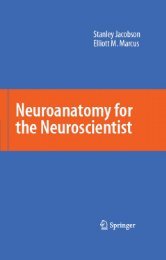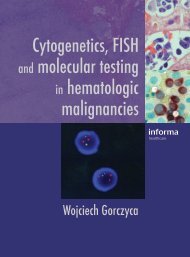Color Atlas of Hematology - Practical Microscopic and Clinical ...
Color Atlas of Hematology - Practical Microscopic and Clinical ...
Color Atlas of Hematology - Practical Microscopic and Clinical ...
- No tags were found...
You also want an ePaper? Increase the reach of your titles
YUMPU automatically turns print PDFs into web optimized ePapers that Google loves.
136 Erythrocyte <strong>and</strong> Thrombocyte AbnormalitiesBone Marrow Cytology in the Diagnosis <strong>of</strong> HypochromicAnemiasSo long as all other laboratory methods are employed, bone marrow cytologyis very rarely needed in cases <strong>of</strong> hypochromic anemia.Bone marrow cytology is rarely strictly indicated after all other availablediagnostic methods have been exhausted (Table 22, p. 130). However, indoubtful cases it can usually at least help to rule out malignant disease.In iron deficiency anemias <strong>of</strong> the most various etiologies, erythropoiesisis stimulated in a compensatory fashion, <strong>and</strong> the distribution <strong>of</strong> themarkers shows the expected increase in red cell precursors. The erythropoiesisto granulopoiesis ratio increases in favor <strong>of</strong> erythropoiesis from1 :3 to 1 :2, but rarely further. The red cell series shows a left shift, i.e.,there are more immature red cell precursors (erythroblasts <strong>and</strong> proerythroblasts)(for normal values, see Table 4). Usually, these red cell precursorsdo not show any clearly atypical morphology, but the cytoplasm is basophiliceven in normoblasts, according with the poor hemoglobinization.Iron staining <strong>of</strong> the bone marrow shows no sideroblasts (normoblasts containingiron granules), or only very few ( 10%, norm 30–40%). A constantfinding in anemia stemming from exogenous iron deficiency is absence <strong>of</strong>iron in the macrophages <strong>of</strong> the bone marrow reticulum.Megakaryocyte counts are almost always increased in iron deficiencydue to chronic hemorrhaging, but can also show increased proliferation iniron deficiency from other causes (which can lead to increased thrombocytecounts in states <strong>of</strong> iron deficiency).In infectious or toxic (secondary) anemia, unlike exogenous iron deficiencyanemia, erythropoiesis tends to be somewhat suppressed. There isno left shift <strong>and</strong> no specific anomalies are present. Granulopoiesis predominates<strong>and</strong> <strong>of</strong>ten shows nonspecific “stress phenomena” <strong>and</strong> a dissociation<strong>of</strong> nuclear <strong>and</strong> cytoplasmic maturation (e.g., cytoplasm that is stillbasophilic with promyelocytic granules in mature, b<strong>and</strong>ed myelocyte nuclei).Depending on the trigger <strong>of</strong> the anemia, the monocyte, lymphocyte, orplasma cell counts are <strong>of</strong>ten moderately increased, <strong>and</strong> megakaryocytecounts are occasionally slightly elevated. The important indicator is ironstaining <strong>of</strong> the bone marrow. The “iron pull” <strong>of</strong> the RES leads to intensiveiron storage in macrophages, while the red cell precursors are almost ironfree.However, combinations do exist, when a pre-existing iron deficiencymeans that the iron depositories are empty even in an infectious or toxicprocess. Moreover, not every secondary anemia is hypochromic. Wherethere is concomitant alcoholism or vitamin deficiency, secondary anemiamay be normochromic or hyperchromic.






